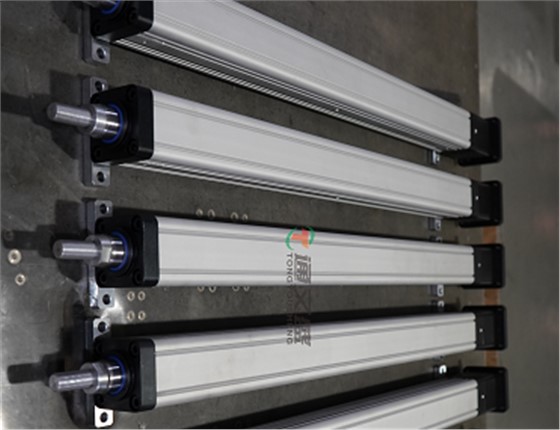In a dusty environment, to ensure the normal operation of long-stroke servo cylinders and extend their service life, a series of targeted maintenance measures need to be implemented, mainly including daily cleaning, sealing inspection and maintenance, lubrication and inspection of key components, etc. The specifics are as follows:
Daily Cleaning
External Cleaning: Regularly use a clean soft cloth to wipe the outer surfaces of the long-stroke servo cylinder to remove accumulated dust. For some hard-to-reach areas, compressed air can be used for blowing, but care must be taken not to use excessively high pressure to avoid damaging the components of the long-stroke servo cylinder.
Internal Cleaning: Regularly open the end cover or protective cover of the long-stroke servo cylinder and use specialized vacuum equipment to remove internal dust. During the cleaning process, care should be taken to avoid damaging internal components such as the screw rod, guide rail, and motor. At the same time, check for areas with excessive dust accumulation and whether dust has entered electrical connection points.
Sealing Inspection and Maintenance
Inspect Seals: Regularly check the seals of the long-stroke servo cylinder, such as O-rings, for wear, aging, or damage. If any issues are found with the seals, they should be replaced promptly to prevent dust from entering the interior of the long-stroke servo cylinder.
Ensure Installation Sealing: When installing the long-stroke servo cylinder, ensure that the mounting surface is flat and clean, and the mounting bolts are tightened evenly to ensure the sealing between the long-stroke servo cylinder and the mounting base. Additionally, the cable interfaces and ventilation openings of the long-stroke servo cylinder should also be sealed to prevent dust from entering through these gaps.

Lubrication and Inspection of Key Components
Lubrication of Screw Rod and Guide Rail: The screw rod and guide rail are key transmission components of the long-stroke servo cylinder, and the dusty environment can exacerbate wear, so regular lubrication is necessary. Use grease suitable for dusty environments, applying or injecting it according to the specified lubrication cycle. Before lubrication, clean the dust off the surfaces of the screw rod and guide rail, and then evenly apply the grease to ensure effective lubrication.
Bearing Inspection: Check the bearings of the long-stroke servo cylinder for wear, jamming, or abnormal noise. Since dust may enter the bearings, leading to damage, regular inspection and maintenance of the bearings are essential. If any issues with the bearings are found, they should be replaced promptly to ensure the normal operation of the long-stroke servo cylinder.
Electrical System Maintenance
Motor Inspection: Check the insulation resistance of the motor windings to ensure good insulation performance. Also, inspect the motor's terminal connections for looseness, and tighten any loose connections promptly to prevent overheating due to poor contact. Additionally, clean the dust from the motor's cooling fan to ensure its proper operation and improve the motor's cooling effect.
Drive Maintenance: Regularly clean the dust from the surface of the drive and check that the heat sinks of the drive are dissipating heat effectively. Observe the operational status indicator lights of the drive; if any abnormalities are noted, timely troubleshooting is necessary. Furthermore, check that the drive parameters are set correctly, and recalibrate and adjust them if needed.
Regular Comprehensive Inspection
Overall Performance Testing: Periodically conduct overall performance testing of the long-stroke servo cylinder, including testing indicators such as load capacity, running speed, and positioning accuracy. Compare the test results with the technical specifications of the long-stroke servo cylinder; if any significant performance decline is observed, investigate the cause and perform repairs promptly.
Structural Inspection: Check whether the structural components of the long-stroke servo cylinder have looseness, deformation, or cracks. In particular, ensure that the bolts at connection points are securely tightened. For any identified issues, repair or replace components promptly to ensure the structural stability and reliability of the long-stroke servo cylinder.


